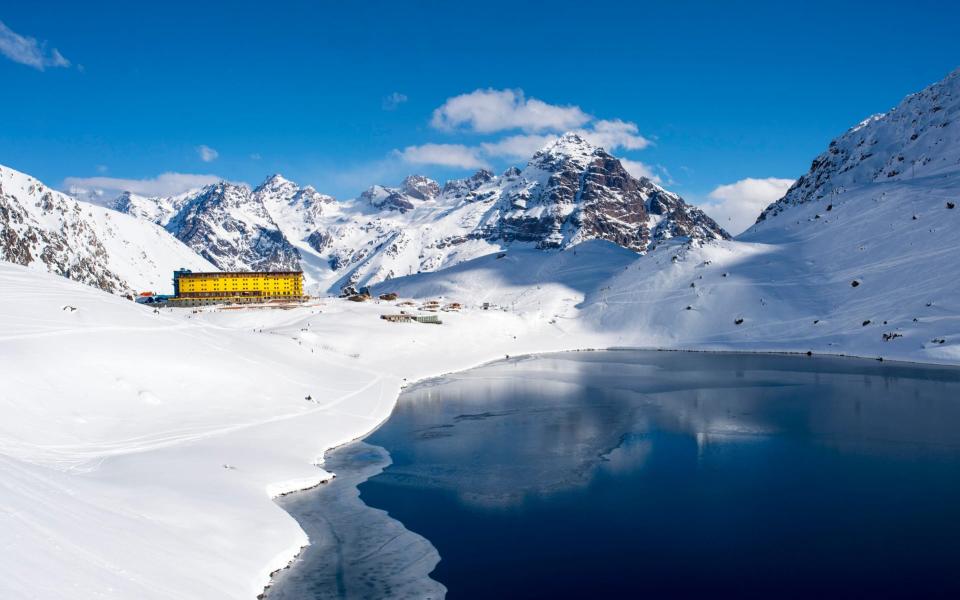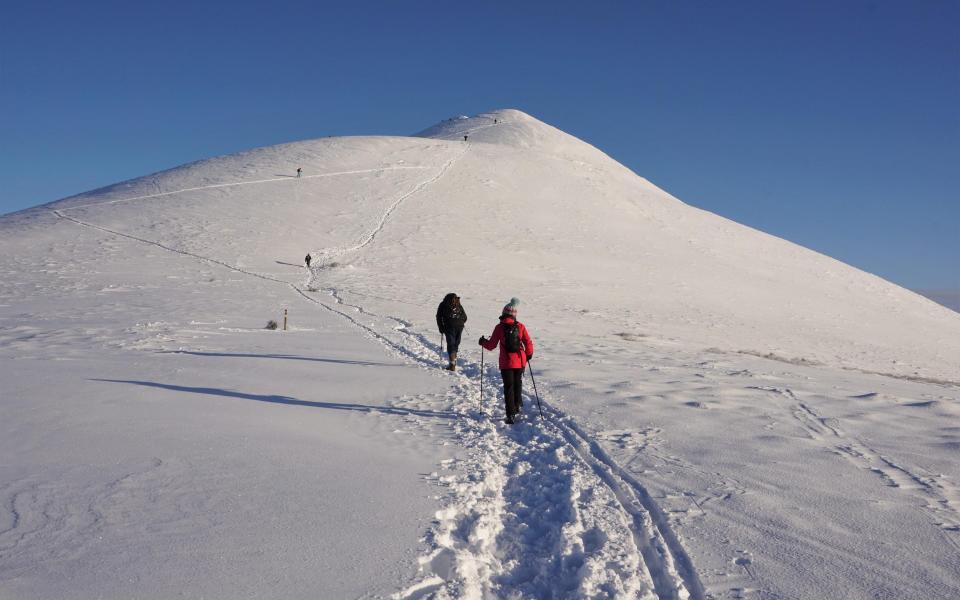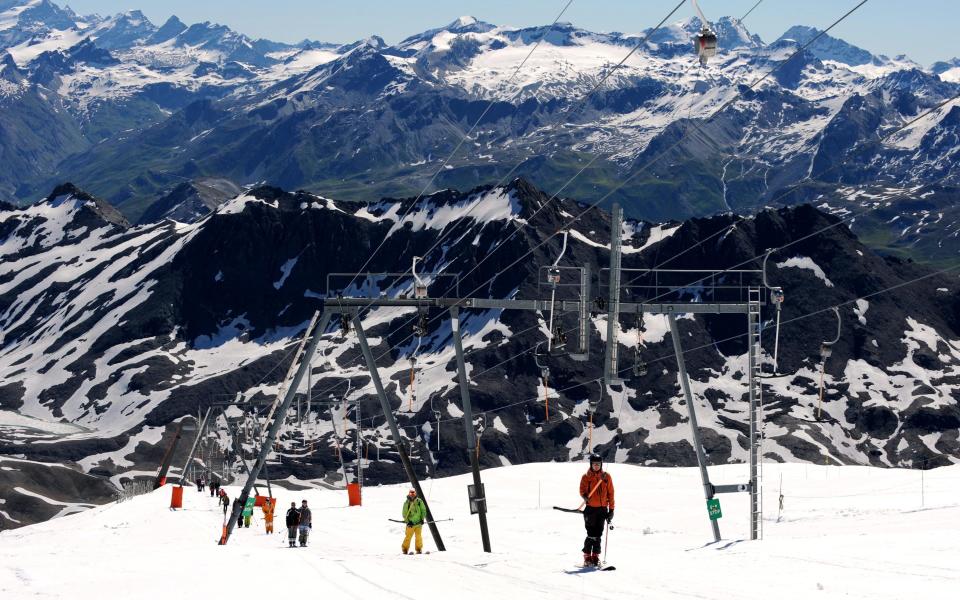Will I be able to ski this summer? Resorts reopening from South America to the Alps

All eyes are on when international travel will resume and whether summer holidays will be allowed to go ahead. But while the majority of Britons are yearning for a week on the beach (they’ve earned it too) the pent up demand among skiers and snowboarders to return to the slopes could see a surge in interest in summer holidays in the mountains.
Currently, according to the Government’s roadmap to ease lockdown restrictions, the earliest international travel will be able to resume is May 17 – luckily for snow sports fans this is just in time for the summer ski season to commence around the globe, whether on European glaciers or in the South American Andes.
Skiing or snowboarding while your neighbour is living it up in a beach bar on their holiday isn’t for everyone – rather than beginners making shaking first turns the mountains in summer tend to be full of enthusiastic adventurous types. Arguably though, it is this group of die-hard ski fans who will be willing to navigate the complicated world of travel restrictions in order to hit the slopes this year.
If that sounds like you, what are the chances of being able to finally carve fresh turns, wherever they may be? After two winters of Covid-fuelled disaster for ski holidays, skiers have every right to be skeptical.
Here we look at the contenders for a summer ski holiday, the likelihood of being able to visit, what the risk is and whether the reward will be worth it.
South America
What are the chances?
Currently British travellers returning from Chile and Argentina in South America face 10 days in isolation in a quarantine hotel, plus the three-test system (one 72 hours before departure, another on day two of quarantine in the UK and a final test on day eight) due their presence on the 'red list' – but this could change after May 17. The current seven-day case rate in Chile is 220 per 100,000, in Argentina it’s 93. Compared to their European counterparts (France, 314; Switzerland, 123; Italy, 248; Austria, 245) that’s promising as is the region’s vaccine drive. What’s more, resorts are making positive noises about reopening – the ski season in South America typically kicks off in mid-June to October.

In a statement, Henry Purcell and Miguel Purcell from Chile’s leading resort Portillo said: “Chile has done well with vaccinations and the Government hopes to be able to vaccinate more than 80 per cent of the public before July.” The resort is set to be able to offer testing to guests, who need them to return home, as part of a string of new Covid regulations, from routine temperature checks, mandatory face masks and enhanced cleaning in the resort’s iconic hotel.
What’s the reward?
Latin America’s ski resorts boast some of the world’s most extreme terrain, plus the chance to ski on active volcanoes while most other people are lazing on a beach. Some of the top resorts to have on your radar include; Portillo in Chile, which wasn't able to reopen last year due to Covid-19, but where slopes reach the lofty altitude of 3,310m, Cerro Catedral, the largest ski resort in Argentina which was the first resort in the Andes to open last summer, and Nevados de Chillán, which sits atop three active volcanoes, six hour’s drive south of the Chilean capital Santiago. Wherever you ski in South America the scenery is unlike anything you’ll have experienced in the Alps – the Andes are the longest mountain range in the world and its peaks tower above the slopes in a dramatic fashion, full of steep chutes and rocky cliffs. Views of Patagonia’s lakes are also plentiful, plus the region's volcanoes regularly put on shows of billowing smoke and mini eruptions for skiers’ viewing pleasure.
The UK
What are the chances?
It’s extremely likely that the UK’s snow sport facilities will reopen in the coming months. If Boris Johnson’s roadmap goes to plan dry ski slopes, which are outdoors, will be allowed to reopen from March 29, followed by indoor snow centres, which fall into the same category as gyms and leisure centres, on April 12. Last summer these centres were able to open successfully thanks to new Covid safety rules – it was mandatory to pre-book lift passes and wear a mask at indoor centres, lessons were held for family bubbles and social distancing, which is relatively easy when wearing a pair of skis, was enforced.
All hope is not lost for Scottish ski resorts either, which have been closed for the majority of the winter due to lockdown. After a bumper season for snowfall, if the white stuff sticks around some resorts might be able to reopen for some last-chance spring turns – it’s not unheard of for there to be skiing in Scotland in May. While unlikely for non-Scots, residents are being told to ‘stay local’ from April 2 and from April 26 the Government hopes to lift all restrictions on travel on mainland Scotland, when ski resorts, gyms and the hospitality industry will also be allowed to partially reopen and groups of six can meet outdoors.

What’s the reward?
The UK’s indoor snow centres and dry ski slopes aren’t to be underestimated – there’s a reason the nation’s top athletes use them regularly for their training. Indoor centres, like The Snow Centre in Hemel Hempstead (a short train journey from London) or Chill Factore in Manchester (home to the UK’s longest indoor slope), are controlled environments – meaning the snow is kept in pristine condition and features such as terrain parks and mogul runs can be built and dismantled quickly. This enables skiers to spend their time, whether on an hourly lift pass or in a lesson, productively – honing their skills and getting fit for the ski season ahead. Likewise, the UK’s dry ski slopes are popular training facilities, particularly with beginners keen to learn the basics before shelling out for a holiday to the mountains – these centres have become a hub for local snow-sport communities and enthusiasts.
Many believe skiing in Scotland is massively underrated – locals who may be lucky enough to visit resorts this year will be able to revel in what remains from a brilliant year of snowfall. Resorts in Scotland offer a ‘back-to-basics’ approach when compared to their European cousins. But for those willing to put in some effort, whether in the form of ski touring or enduring an old lift system, to earn their turns the chance to ski on home soil is worth it.
Europe
What are the chances?
There is still much uncertainty about trips to Europe this summer, where a third wave of infections and lockdowns has put Alpine nations such as France, Austria, Switzerland and Italy on the back foot, as government’s grapple to distribute vaccinations. Despite the likes of Spain, Cyprus and Greece making positive sounds about reopening to vaccination Britons, or those who test negative or can provide proof of antibodies, unfortunately, none of these countries offer summer skiing. Grant Shapps’ Global Travel Task Force will reopen on April 12 about future plans for international travel, only then will we know where (if anywhere) we’ll be able to visit this summer. Reassuringly though resorts are primed and ready to welcome visitors. Ski resorts in Switzerland have been open fully throughout the winter and their counterparts in France and Italy, while not able to open lifts, have also welcomed local holidaymakers, who’ve been kept safe thanks to the implementation of social distance, mandatory masks and increased hygiene protocols.
What’s the reward?
The mountains of Europe are often an underrated summer destination, with (normal) visitor numbers a fraction of what they are in winter. But that’s not a reflection of the activities on offer to holidaymakers. Aside from hiking, mountain biking, climbing and open-water swimming, skiing and snowboarding is possible at a number of resorts during the summer months thanks to high-altitude snow-sure glaciers.

The likes of Tignes and Les Deux Alpes in France (both of which has confirmed they plan to open for the summer if allowed), Zermatt in Switzerland (which has remained open during the entirety of the pandemic) and Cervinia in Italy (which opened successfully last summer and hopes to again this year) are popular with ski schools who run intense training courses during the summer. Mornings are usually spent on the glacier skiing and afternoons in the resort, doing dry-ground training or enjoying everything else the resort has to offer – it’s the best of both worlds for people who enjoy being in the mountains, whatever the weather.
New Zealand and Australia
What are the chances?
It’s extremely unlikely that trips Down Under will recommence this year – in fact Australia and New Zealand’s borders are likely to remain closed until 2022. Last summer resorts in both Australia and New Zealand were able to open and lift tickets sold out in record-breaking time – but it was a turbulent season, plagued by closures as regions were plunged back into lockdown. Capacity on the slopes was reduced, group lessons were banned and all lift passes needed to be bought online in advance – this year resorts are hoping to reopen as planned (in May to June until late September) but similar restrictions will be in place.
What’s the reward?
Despite Brits usually flocking to Australia and New Zealand for a dose of winter sun, during the summer (their winter) there’s plenty of ski resorts to choose from in both nations.
While Coronet Peak leads the charge in New Zealand, along with Cardrona and Mount Hutt, ski resort giant Vail Resorts owns and operates three of Australia’s biggest winter destinations, Perisher, Falls Creek and Hotham (all of which are covered by its Epic pass). They’re all internationally acclaimed ski areas, offering similar terrain to North America and the Alps and impressive snow records – but with locals travelling for day trips very few have the ‘resort’ set up European skiers are used to, with accommodation usual located away from the ski area.


